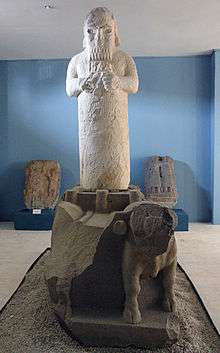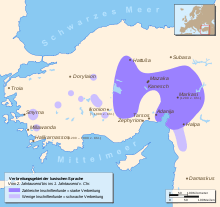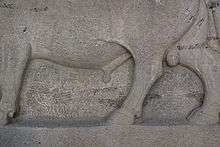Çineköy inscription


The Çineköy inscription is a Hieroglyphic Luwian-Phoenician bilingual inscription, uncovered in 1997 in Çineköy, Adana Province, Turkey (ancient Cilicia). The village of Çineköy lies 30 km south of Adana.
The inscription is dated to the 8th century BC. It was originally published by Tekoglu and Lemaire (2000).[1] Another important inscription of the same type is known as the 'Karatepe inscription', which was known earlier. Both of these inscriptions trace the kings of ancient Adana from the "house of Mopsos" (given in Hieroglyphic Luwian as Moxos and in Phoenician as Mopsos in the form mps). He was the legendary king of antiquity.
Background
The object on which the inscription is found is a monument to the Storm God Tarhunza.
The inscription was authored by the man known as Urikki in Assyrian texts, which is equivalent to Warika, or Awariku in Luwian. He was the vassal king of Quwê (Assyrian name), the modern Cilicia. In Luwian this region was known as 'Hiyawa'.[2]
In this monumental inscription, Urikki made reference to the relationship between his kingdom and his Assyrian overlords.
Significance
The Çineköy inscription was the subject of a 2006 paper published in the Journal of Near Eastern Studies, in which the author, Robert Rollinger, lends support to the age-old debate of the name "Syria" being derived from "Assyria" (see Etymology of Syria).
The Luwian inscription reads "Sura/i" whereas the Phoenician translation reads ’ŠR or "Ashur" which, according to Rollinger (2006), "settles the problem once and for all".[3]
The text

The examined section of the Luwian inscription reads:
- §VI And then, the/an Assyrian king (su+ra/i-wa/i-ni-sa(URBS)) and the whole Assyrian "House" (su+ra/i-wa/i-za-ha(URBS)) were made a fa[ther and a mo]ther for me,
§VII and Hiyawa and Assyria (su+ra/i-wa/i-ia-sa-ha(URBS)) were made a single “House.”
- §VI And then, the/an Assyrian king (su+ra/i-wa/i-ni-sa(URBS)) and the whole Assyrian "House" (su+ra/i-wa/i-za-ha(URBS)) were made a fa[ther and a mo]ther for me,
The corresponding Phoenician inscription reads:
- And the king [of Aššur and (?)]
- the whole “House” of Aššur (’ŠR) were for me a father [and a]
- mother, and the DNNYM and the Assyrians (’ŠRYM)
- were a single “House.”
Also, in the inscription, Awariku claims to have built 15 fortresses in his kingdom.[4]
| Wikimedia Commons has media related to Çineköy bilingual. |
See also
External links
- Inscription From 800 BC Shows the Origin of the Name 'Syria'
- Nytt fynd stärker samband mellan suroye-asuroye (in Swedish)
- Neue Entdeckung erhöht Verbindung zwischen Suroye und Asuroye (in German)
References
- ↑ Tekoglu, R. & Lemaire, A. (2000). La bilingue royale louvito-phénicienne de Çineköy. Comptes rendus de l’Académie des inscriptions, et belleslettres, année 2000, 960-1006.
- ↑ Trevor Bryce, The World of The Neo-Hittite Kingdoms: A Political and Military History. Oxford University Press, 2012 ISBN 0199218722
- ↑ Rollinger, Robert (2006). "The terms "Assyria" and "Syria" again" (PDF). Journal of Near Eastern Studies. 65 (4): 284–287. doi:10.1086/511103.
- ↑ Trevor Bryce, The World of The Neo-Hittite Kingdoms: A Political and Military History. Oxford University Press, 2012 ISBN 0199218722
Coordinates: 36°47′54″N 35°15′37″E / 36.79833°N 35.26028°E